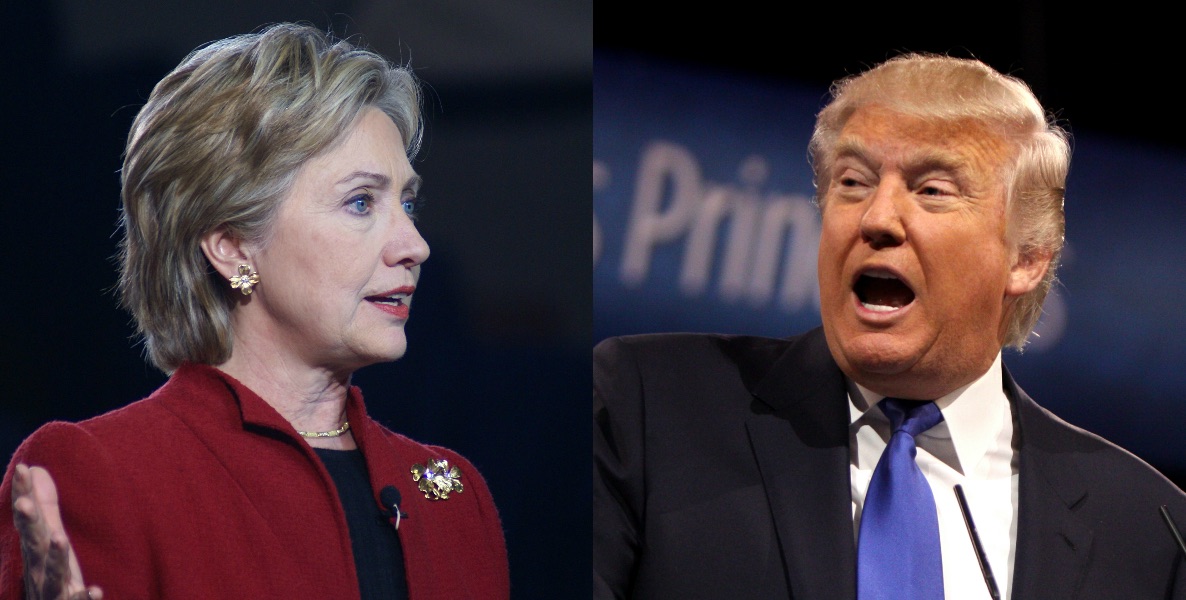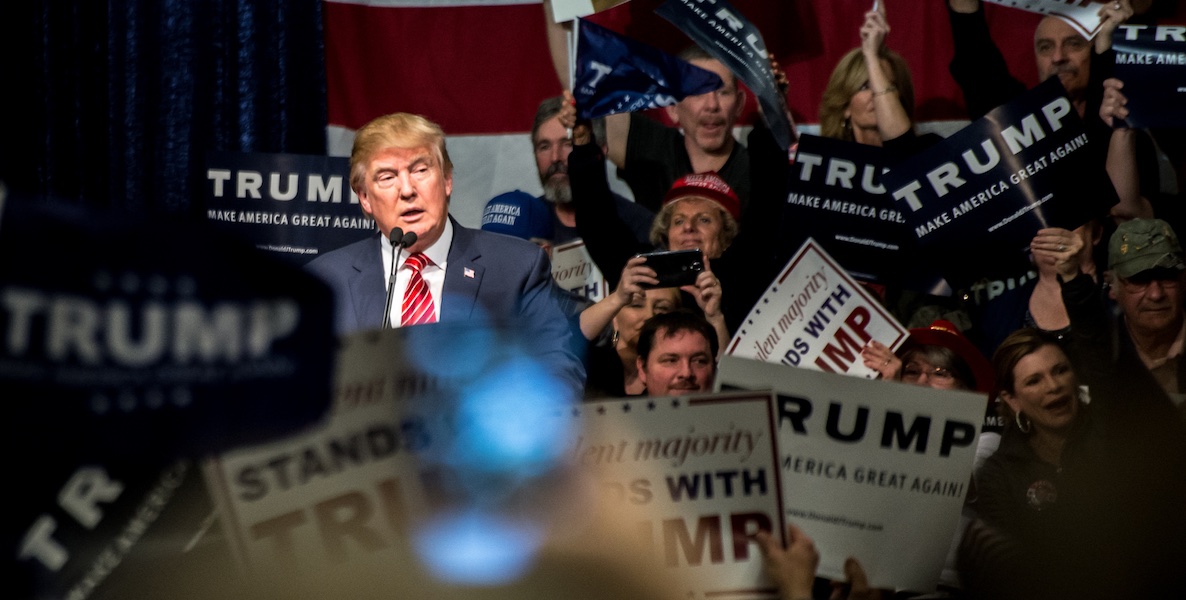State of the Race
During the past two weeks, the 2016 Presidential election has turned decidedly in favor of Hillary Clinton. Trump’s post-Cleveland bounce dissipated and national polls show an ever-widening lead for the Democratic nominee.
The McClatchy-Marist poll, released on August 4, showed a Clinton lead of 15 points, the widest to date. And while other polls have the Clinton margin at from 5 to 10 percent, the trend lines are clear. The most recent Real Clear Politics poll average has Clinton up by 7 percentage points.
If Trump continues to pile up self-inflicted wounds, Clinton could be headed to a landslide victory. Trump’s Putin comments, his criticism of the Khan family, his casual lying and lack of familiarity with constitutional law all help to disqualify him in the eyes of an ever-increasing number of voters.
Moreover, narcissism makes it hard to pivot. After all, why change if crowds keep applauding? So Trump doubles down even as his numbers sink. If you want a lesson in the consequences of believing a narrow echo chamber, listen to a Trump rally and compare the rhetorical confidence to the national polls.
If he is to turn this around, Trump must realize that his core support is not large enough to be competitive. He is still rehashing primary victories as if that matters. Yes, he got more votes than any Republican primary candidate but he also had more votes cast in favor of others than any previous Republican primary victor. And his 13 million votes pale in comparison to the 16 million votes that Hillary Clinton received during the Democratic primaries.
Trump needs to come to terms with real math and stop gloating about past glory. The shift from the primaries to a general election campaign requires maintaining your base and widening your appeal. If he continues like this, Libertarian candidate Gary Johnson may reach Ross Perot-like third party numbers (19 percent in 1992).
Countering Reality
As an inoculation to reality, Trump and some supporters are authoring two stories: The first is a conspiracy tale and the second is an electoral fantasy. The conspiracy is that the election will be rigged by the media and insider politicians. His loss will be a robbery. He hints at dark forces protecting political and business elites from a popular savior—Trump.
Of course he never tells us how this will happen or who is really behind it. This rhetoric is also disqualifying, and not befitting a constitutional republic that has had a pretty good run for 230 years.
Voters make a distinction between Clinton’s occasional political lies and Trump’s foundational disqualifications. The former is the expected fare of the trade. Politicians inflate resumes and obfuscate answers. The latter is in conflict with expected reason and qualifications, and represents national risk.
The second story is more fantastic than conspiratorial. Some Trump enthusiasts on the Internet say that all of the polls are meaningless, because there are vast number of traditional non-voters that will show up for Trump, and those voters are not being captured by polls. They point to the election of 2012 where 126 million people voted for either Obama or Romney, while 93 million eligible voters never voted for anyone.
It is true that the United States—compared to many nations—has low voter turnout rates, but there is no evidence that 2012 or 2008 non-voters are Trump voters. The missing millions argument that will create a Trump landslide sounds more desperate than anything. Like medieval stories of Prester John, the contrived Christian army in central Asia ready to ride to the rescue, this is a projection of need, not an assessment of reality.
Distrust Versus Disqualification
With three months to go, a lot can happen, but as long as the election is about Trump, Clinton wins. That means Clinton has to stop reminding Americans why they don’t like her very much, either. The latest faux pas: her inability to distinguish between what the FBI director said about her statements to them versus what she said publicly much earlier. There is a discrepancy, one that caused the Washington Post fact-checkers to give her four Pinocchios.
But voters make a distinction between Clinton’s occasional political lies and Trump’s foundational disqualifications. The former is the expected fare of the trade. Politicians inflate resumes and obfuscate answers. The latter is in conflict with expected reason and qualifications, and represents national risk.
To close the gap, Trump will have to make Clinton’s character seem just as disqualifying. It is doubtful he can do that to a former Senator and Secretary of State who is being promoted by a popular sitting President. More importantly, Trump will have to demonstrate a command of the seriousness of the office. Being President is not a branding strategy for product sales. Demonstrating Presidential qualities may be insurmountable for his candidacy.
Global Complexity
The greatest downside of the electoral battle is that issues we need to debate as a nation are moved to the side. We are debating Trump and Clinton, not trade, the economy, national security, or immigration—not in a serious way.
The issues that animate the candidacies of Sanders, Trump, and to a lesser extent, Libertarian Gary Johnson and the Green Party’s Jill Stein, may not get much daylight outside of sound bites and slogans. Yet globalization and its meaning for American jobs, equality, sovereignty, security, and demography are cornerstones of national discontent both from the right and left.
Globalization has winners and losers as Branko Milanovic, in his epic Global Inequality: A New Approach for the Age of Globalization, demonstrates. It is not just the wealthy who have gained, but so have the poor and near poor from the developing world. Globalization has been a massive anti-poverty program at the same time it has depressed the wages of portions of the middle class and poor in the developed world, including the United States.
Yet globalization—as economic policy and as a cultural and historical process—is not going anywhere. And in so many ways we should want it to succeed. Global integration diminishes the threat of war, as there are more reasons for national inter-dependence. Anyone who thinks that the project of the E.U. was simply about bankers and bureaucrats in Brussels forgets 20th century European history, where two World Wars took the lives of 70 million people. The E.U. project has always meant so much more.
Bill Clinton, in his 1996 reelection campaign, famously used the phrase building a bridge to the 21st century. It was a great political phrase because it was both aspirational and had the capacity to refer to substantive policies in education, infrastructure, and regulatory issues. It was future-oriented and not nostalgic. In contrast, this campaign is becoming increasingly defensive about the future.
Given the inevitability of globalization, what national policies and trade policies will increase economic growth and incomes for U.S. poor and middle classes? Do we have to pursue mercantilist protection policies as many nations do? Or is there a more robust public support system for those whose employment prospects are curtailed? Do we simply need trade policies that ensure fair trade? Or do we need to pursue a more entrepreneurial course of capitalism that may create the next wave of employment opportunities?
Those are issues that deserve thoughtful debate rather than sloganeering.
Let’s take manufacturing as an example of a complex issue that needs to be better understood. Manufacturing conveys so many issues of importance: middle class wages, trade policy, and technology. Moreover it speaks to particular parts of the nation (the so-called Rust Belt) that a few weeks ago seemed to be in play for Trump, and still could be over the next 88 days.
Finally, manufacturing reaches into our national psyche about the past, returning us to a time when the industrial economy seemed so different from one based on financial trading and the rapid disintermediation of familiar institutions, from hotels to taxis to banks.
Whether you are on the right or the left, you mourn the loss of manufacturing jobs that provided relatively high wages for those without college degrees. Moreover, you point to empty factory buildings and complain about trade deals with Mexico, currency manipulation by China, or slave wages in many parts of the world.
Here are three things to note that you may not hear in the Presidential debates:
- Economic value and jobs: The value of American manufacturing (its output) is as high as it has ever been. And as a percentage of GDP (about 12 percent) manufacturing punches above its weight class. What has declined dramatically is the number of manufacturing jobs: from a peak of about 20 million jobs in 1979 to about 12 million today. Job loss accelerated after 2000. U.S. manufacturing jobs still pay well for non-college educated workers compared to other industries. Currently there is a positive job trend upward but it is hard to assume a longer-term pattern based on those numbers.
- Innovation versus trade deficits: A major source of job loss is not just globalization but higher productivity through innovation and technology. It takes fewer people to produce more goods. But job losses are also driven by trade deficits in manufacturing, particularly during the past decade. It is the past 15 years that need to be better understood, not NAFTA. Compared to most advanced nations where wages are also high, US manufacturing job losses have been more pronounced.
- Can we compete?: Of course we can compete, and we are doing so today in both durable goods manufacturing and in more boutique advanced manufacturing comprised of smaller shops. But we do not want to compete for the lowest wage manufacturing jobs. Many of those labor-intensive assembly line functions will be lost. And in fact lower wage nations will lose them to still lower wage nations, and job numbers in those nations will decline as productivity rises. It is already happening.
But we can stabilize and even increase job numbers and output value by: (1) ensuring that unfair trade and currency practices are curtailed; (2) enabling investment in training and R&D, as the Germans, for example, have done so effectively; and (3) making the tax and regulatory codes less onerous for small manufacturers, in particular.
To re-think manufacturing strategy in the United States requires investing in an educational system that links apprentice-like training to advanced manufacturing shops and processes; providing more public R&D support; more aggressively enforcing fair trade standards; coming to terms with the fact that certain jobs will not return in an age of technological change, and embracing the boutique maker opportunities of new technologies from 3-D printing to the use of virtual reality as a prototyping agent.
Bill Clinton, in his 1996 reelection campaign, famously used the phrase building a bridge to the 21st century. It was a great political phrase because it was both aspirational and had the capacity to refer to substantive policies in education, infrastructure, and regulatory issues. It was future-oriented and not nostalgic. In contrast, this campaign is becoming increasingly defensive about the future, without offering enough debate about how we can prosper as we move forward. Let’s hope the level of our current debate gets a lot smarter in a hurry.
Header photo: Hillary Clinton (Flickr/Marc Nozell) and Donald Trump (Flickr/Gage Skidmore)







